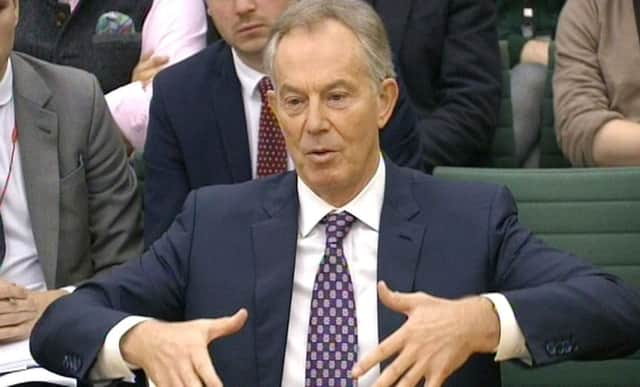Leaders: Lessons can be learned from Blair’s Libyan efforts


Former prime minister Tony Blair had some fascinating new reflections to offer the Commons foreign affairs committee on his controversial efforts to help thaw relations between the West and Libya.
He offered an unsurprisingly staunch defence of the so-called “deal in the desert” with Colonel Gaddafi when he was in Downing Street and a strategy of bringing the Libyan dictator “in from the cold”.
Advertisement
Hide AdAdvertisement
Hide AdHe argued that Gaddafi’s stockpile of chemical weapons could still have been in circulation today had he not decided to try to break the long impasse, which could be traced back to the Lockerbie bombing.
The 2004 deal ended those long years of isolation and offered the support of Western oil companies to help extract Libya’s natural resources in exchange for giving up its weapons of mass destruction and renouncing terrorism.
Mr Blair told MPs: “Ultimately the game was worth it, but that does not mean I approved of the way he ran his country. I had the hope – probably misplaced – that he would engage in political and economic reform.”
There is much to learn from the intentions and actions of Mr Blair in trying to develop a better relationship with Gaddafi, especially considering the levels of instability that still exist in the Middle East. He believes the deal with Gaddafi may have prevented chemical weapons from falling into the hands of the so-called Islamic State, considering the group’s widespread presence in Libya since the Gaddafi regime was overthrown four years ago.
He admitted that his decision to engage with Gaddafi had been “difficult because of the nature of the regime and the individual we were dealing with”, but insisted it had been a worthwhile process to protect the security of Britain and “because of the broader interest of trying to engage a country like that in a process of change”. There are real parallels with Syria there.
Mr Blair’s evidence throws up a fundamental question for the West over whether it should move to tackle the killing of thousands of innocent people by ruthless despots trying to cling on to power. What history has taught us over Libya, Syria and Iraq is that things are rarely as easy as they seem. As Mr Blair said yesterday, there is a “pretty thin” line between intervention on humanitarian grounds and bringing about regime change.
The West probably should decide on principle whether it wants to act in the defence of people who are being subjugated or whether it is going to simply stay out. The truth of the matter is it will pick sides where it thinks its interests lie and where it thinks it can do something, which is not always the best way.
Mr Blair has highlighted that there was no robust restructuring plan for Libya when the Gaddafi regime was gone. One of the lessons to be learned from Libya is that the West needs to think carefully in Syria about what happens when Islamic State is defeated and how the civil war in Syria should be handled.
Advertisement
Hide AdAdvertisement
Hide AdMoving against IS is not the same as moving against Gaddafi or Saddam Hussein. It is something that has to be done by an international coalition and then a political deal over Syria will need to be worked out.
Little clamour for festive dark ages
IT is already hard to recall the eerily quiet scene that could be found in the heart of Edinburgh’s Royal Mile after dark this time last year. The Street of Light, the vast installation introduced to Scotland’s most historic thoroughfare, is thronged with up to 5,000 visitors a night. And its organisers have revealed almost all of the 250,000 free tickets have been snapped up.
Thousands of remarkable images created by the installation, which features more than 60,000 lights, have been sent round the world via social media. Now Underbelly, the promoters brough in to revitalise Edinburgh’s festive offering, have suggested other parts of the Old Town could also benefit from future events. This may bring some comfort to businesses in some parts of the city who look on enviously at the huge crowds thronging The Mound and St Andrew Square. But it may also set alarm bells ringing with some of the city’s heritage guardians after persistent rumblings of discontent about the commercialisation of public spaces. For some of the city’s more vocal watchdogs, the limits of good taste have been breached with the transformation of St Andrew Square by an ice rink, bars and an indoor marquee for Fringe-style shows. Judging by some of the comments it appears as if some people would rather all of Edinburgh’s festive attractions and light shows could be made to vanish overnight.
It is hard to fathom why Edinburgh should be treated as some kind of museum piece when towns centres across Scotland are lit up by festival attractions, markets and outdoor bars, never mind some of its rivals around continental Europe. And it would be hard to find much support in the business community for a return to the festive dark ages.